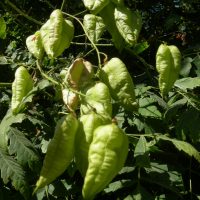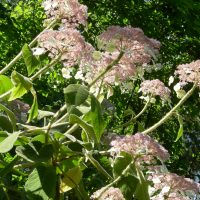September Color Appears at the Washington Park Arboretum
“Ornamental Late Summer Fruits”
1) Betula lenta (Sweet Birch)
The fruit, maturing in fall, is composed of numerous tiny winged seeds packed between the catkin bracts.
Twigs, when scraped, have a strong scent of oil of wintergreen.
Several specimens are located east of Azalea Way bordering the wetland bog.
2) Liriodendron tulipifera (Tulip Tree)
The fruit is a cone, two to three inches long, made of a great number of thin narrow scales attached to a common axis.
Read moreTrees are showing off their fall bounty

These 3-parted pods contain the seeds of the Koelreuteria paniculata or Golden Rain Tree. This tree is native to East Asia, China & Korea and is used as an ornamental for its flowers, leaves and seed pods. Although it is considered an invasive in the SE United States. The Arboretum’s free Sunday walks for the month of September will feature the “Fruits & Nuts” of this tree and many others in the collection.
Read moreWe Have Winners!
The UWBG Kids Digital Photography Contest was a complete success! We had 12 entries, ranging from ages 7 to 16, who submitted some really incredible artwork.
Read moreAugust Color Appears at the Washington Park Arboretum
1) Blechnum chilense
This impressive evergreen fern grows in full sun to full shade.
The Chilean Spanish name ‘Costilla de vaca’ translates into “cow’s rib” and refers to the shape of the fronds.
This fern can be found thriving in the Chilean Entry Garden in Pacific Connections.
2) Eucalyptus pauciflora ssp. niphophila
Beautiful peeling brown bark is just one of the attributes of this Australian native.
Read moreIt’s Hydrangea Season

All of the Hydrangeas in the park are at their prime flowering beauty right now. Its a great month to go on one of our free Sunday tours with a guide and walk down Arboretum Drive to view the variety of Hydrangeas in the UW collection which includes everything from exotic Asian vines to the bluest mopheads I’ve seen in a while to the pictured Hydrangea aspera – my personal favorite.
Read moreJuly Color Appears at the Washington Park Arboretum
1) Berberis darwinii
Vigorous, upright evergreen shrub with spine-toothed, glossy leaves and spherical blue-glaucous fruit.
This specimen is located along the Pacific Connections Meadow Loop Trail within the Chilean Entry Garden.
First discovered by Charles Darwin in 1835.
2) Hydrangea serrata ‘Bluebird’
Compact, erect deciduous shrub with flattened corymbs containing a few pink or blue sterile flowers and numerous fertile flowers within.
Read moreThe Montezuma Pine
Our free Weekend Walks topic for the month of July is conifers, therefore it seems appropriate to feature one of my favorite trees in the arboretum collection: the Montezuma Pine located in crabapple meadow.
Read moreHorticulture Vignettes from a Busy Spring in the Gardens
“Something old…”
OK, so there’s the “old”, as in “enough already”, cold wet spring weather that seems to be continuing into summer and creating a monster weed season for us. And, there’s the “old” as in a staff milestone reached in age by none other than Riz Reyes, Soest Gardener. Sure, compared to most of our seasoned horticulture staff, he’s still just a sapling in the woods at 30, but ever so slowly, he’s beginning to put down roots and develop heartwood, true elements of perennial long-life.
More Service Learning at the Arboretum
Posted on behalf of Will Pleskow, UW student and UWBG volunteer service learner
I never thought weeds would be so endless and time consuming but I certainly have a new perspective on weeding after many back-breaking hours digging out seemingly endless little green plants. All of the planting and weeding that I have done and will do take place right outside the greenhouse in a secluded part of the Arboretum used for plant propagation.
June Color Appears at the Washington Park Arboretum
1) Argyrocytisus battandieri (Pineapple Broom)
Don’t worry if you can’t pronounce the Latin name; the common name tells it like it is.
Yellow, “pineapple”-scented, leguminous flowers with silvery foliage.
This drought-tolerant shrub from Morocco is one tough plant that thrives in poor soils.
Named for the French pharmacist and botanist, Jules Aimé Battandier.
Located along Arboretum Drive in our Legume Collections.